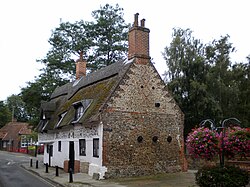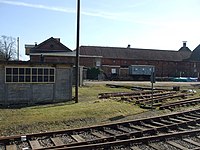East Dereham: Difference between revisions
Created page with '{{Infobox town |name=East Dereham |county=Norfolk |picture=Bishop Bonner's Cottage Museum.JPG |picture caption=Bishop Bonner's Cottage Museum |os grid ref=TF988132 |latitude=52.6…' |
|||
| Line 41: | Line 41: | ||
The town lies on the site of a monastery founded by Withburh, known locally as Saint Withburga, in the seventh century. A holy well at the western end of St Nicholas' Church supposedly began to flow when her body was stolen from the town by monks from Ely, who took the remains back to their town. | The town lies on the site of a monastery founded by Withburh, known locally as Saint Withburga, in the seventh century. A holy well at the western end of St Nicholas' Church supposedly began to flow when her body was stolen from the town by monks from Ely, who took the remains back to their town. | ||
The legend states that monks from Ely came up the river at night and stole Withburh's body, taking it back to Ely to rest with her sisters, who were already considered saints. However, there is currently no river connecting Ely with East Dereham nor likely to have been such a channel, and the tale may originally have meant [[West Dereham]], from where fenland streams do indeed stretch to Ely. However, East Dereham continues to be considered the site of Withburga's home and violated grave. | The legend states that monks from Ely came up the river at night and stole Withburh's body, taking it back to Ely to rest with her sisters, who were already considered saints. However, there is currently no river connecting Ely with East Dereham nor likely to have been such a channel, and the tale may originally have meant [[West Dereham]], from where fenland streams do indeed stretch to Ely.<ref>Garmondsway's notes to his translation of the ''Anglo-Saxon Chronicle'' assume West Dereham</ref> However, East Dereham continues to be considered the site of Withburga's home and violated grave. | ||
In the 18th century an attempt was made to turn Dereham into a new [[Buxton]] or [[Bath]] by building a bath house over Withburga's Well. It was described at the time as a hideous building of brick and plaster and was never popular. In 1880 the local vicar, Reverend Benjamin Armstrong obtained permission to pull the building down. The spring was then protected by iron railings, but fell out of use and became choked with weeds. Since 1950, however, it has been kept clear of weeds, though the railings still prevent access to the waters. | In the 18th century an attempt was made to turn Dereham into a new [[Buxton]] or [[Bath]] by building a bath house over Withburga's Well. It was described at the time as a hideous building of brick and plaster and was never popular. In 1880 the local vicar, Reverend Benjamin Armstrong obtained permission to pull the building down. The spring was then protected by iron railings, but fell out of use and became choked with weeds. Since 1950, however, it has been kept clear of weeds, though the railings still prevent access to the waters. | ||
Latest revision as of 08:24, 24 September 2011
| East Dereham | |
| Norfolk | |
|---|---|
 Bishop Bonner's Cottage Museum | |
| Location | |
| Grid reference: | TF988132 |
| Location: | 52°40’56"N, 0°56’26"E |
| Data | |
| Population: | 15,659 (2001) |
| Post town: | Dereham |
| Postcode: | NR19, NR20 |
| Dialling code: | 01362 |
| Local Government | |
| Council: | Breckland |
| Parliamentary constituency: |
Mid Norfolk |
East Dereham, also known as Dereham, is an endearing town in Norfolk. It is on the main road from Norwich to King's Lynn (the A47), some 15 miles west of the City of Norwich and 25 miles east of King's Lynn.
The village of West Dereham lies not next door as one might expect, but fully 25 miles away.
About the town

Notable buildings in the town include the pargetted Bishop Bonner's Cottage, built in 1502, the Norman parish church, a windmill and a large mushroom-shaped water tower. The Gressenhall Museum of Rural Life is nearby. The town also hosts the headquarters of the Mid-Norfolk Railway, which runs trains over an 11.5-mile railway to Wymondham, as well as owning the line 6 miles north to North Elmham and County School Station.
Dereham labels itself "The Heart of Norfolk". due to its central location in the county. (The ugly Tesco car park beyond the east end of the town is homorously cited as the exact centre.[1]) In the spring of 1978, the "Heart" was given the seven-mile £5m part-dual-carriageway A47 bypass. A section of this road, between Scarning and Wendling was built along the former railway line towards Swaffham and King's Lynn. (This section of railway had been used as a location for the filming of Dad's Army, where Captain Mainwaring is left dangling from a railway bridge after an impromptu flight on a barrage balloon.)
History

Dereham's earliest origin is not known but its name is Old English, suggested to come from a deer park or other farm, although it is known that the town pre-dates the Saxon era.[2] Saint Wihtburh, the youngest daughter of Anna, King of the East Angles, founded a monastery there in the seventh century after seeing a vision of Mary, mother of Jesus; the monastery is mentioned by Bede, but little further is known of it.
Many of the town's ancient buildings were destroyed in the serious fires that took place in 1581 and 1659. Notable buildings that survived the fire include the Church of Saint Nicholas' and the nearby Bishop Bonner's cottage: a delightful house, once home to a most notorious man.
Railways
The railway arrived in Dereham when a single track line to Wymondham opened in 1847. In 1848 a second line, to King's Lynn was opened. In 1849 a line from Dereham to Fakenham was opened, this line being extended to the coastal town of Wells next the Sea by 1857. In 1862 the town's railways became part of the Great Eastern Railway. The town had its own railway depot and a large complex of sidings, serving local industry. In 1882 the line between Dereham and Wymondham was doubled, to allow for the increasing levels of traffic.
In 1964 passenger services between Dereham and Wells were withdrawn, and the track between Fakenham and Wells was lifted soon after. In 1965 the line from Dereham to Wymondham was returned to single track, with a passing loop at Hardingham. The line to King's Lynn was closed in 1968, and the last passenger train on the Dereham to Wymondham line ran in 1969 although the railway remained open for freight until 1989.
The railway between Dereham and Wymondham has been preserved, and is now operated as a tourist line by the Mid-Norfolk Railway Preservation Trust. This charitable company also owns the line north towards County School railway station and aims to eventually relay the line to Fakenham.
Saint Withburga
The town lies on the site of a monastery founded by Withburh, known locally as Saint Withburga, in the seventh century. A holy well at the western end of St Nicholas' Church supposedly began to flow when her body was stolen from the town by monks from Ely, who took the remains back to their town.
The legend states that monks from Ely came up the river at night and stole Withburh's body, taking it back to Ely to rest with her sisters, who were already considered saints. However, there is currently no river connecting Ely with East Dereham nor likely to have been such a channel, and the tale may originally have meant West Dereham, from where fenland streams do indeed stretch to Ely.[3] However, East Dereham continues to be considered the site of Withburga's home and violated grave.
In the 18th century an attempt was made to turn Dereham into a new Buxton or Bath by building a bath house over Withburga's Well. It was described at the time as a hideous building of brick and plaster and was never popular. In 1880 the local vicar, Reverend Benjamin Armstrong obtained permission to pull the building down. The spring was then protected by iron railings, but fell out of use and became choked with weeds. Since 1950, however, it has been kept clear of weeds, though the railings still prevent access to the waters.
Industry and employment

Dereham was the home to the "Jentique" furniture factory which made boxes for both instruments and bombs during the Second World War. The town was also the home to the Metamec clock factory. "Hobbies of Dereham" produced plans, kits and tools, including their famous treadle fretwork saws, for making wooden models and toys which were popular in the days before moulded plastic. At one point Hobbies owned 10 shops in prestige locations all over Britain. The firm ultimately closed in 2009.
Cranes of Dereham and its successor the Fruehauf trailer company was a major employer in the town for many decades. Cranes built nearly all the giant trailers (100 tons plus) that carried equipment such as transformers at slow speeds across Britain. The launch of a new trailer was treated rather like that of a ship with lots of people coming out to see the leviathan move through the narrow streets of the town towards the A47. The town also had several large maltings. Almost all this large scale industry has drifted away since the 1980s.
References
- ↑ http://www.edp24.co.uk/Content/Postcard_From/dereham.asp Eastern Daily Press, Postcard from Dereham
- ↑ http://www.derehamtimes.co.uk/content/derehamtimes/content/Community/DerehamHistory.aspx Dereham Times, About Dereham
- ↑ Garmondsway's notes to his translation of the Anglo-Saxon Chronicle assume West Dereham
Outside links
| ("Wikimedia Commons" has material about East Dereham) |
